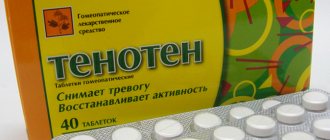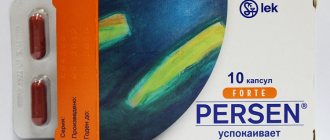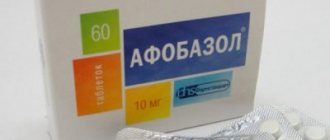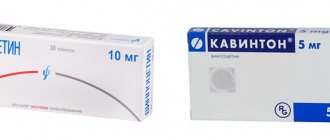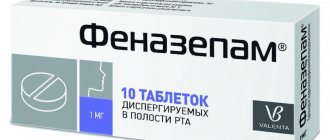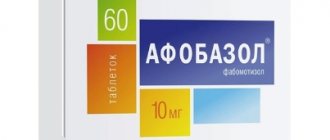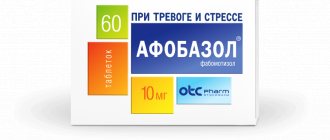In the modern rhythm of life, people are often exposed to stress . There can be a great many reasons for this: family problems, problems at work, etc. Many people try to cope with stress and panic attacks on their own. However, this does not always work out. Then you have to resort to taking medications. Popular ones are Phenazepam and Afobazole . When faced with the need to take such medications, people wonder which one is best? To do this, it is necessary to compare drugs.
Comparison of the effectiveness of Afobazole and Phenazepam
Phenazepam is more effective than Afobazole - this means that the ability of the drug substance to provide the maximum possible effect is different.
For example, if the therapeutic effect of Phenazepam is more pronounced, then with Afobazole it is impossible to achieve this effect even in large doses.
Also, the speed of therapy is an indicator of the speed of therapeutic action; Phenazepam and Afobazole are also different, as is bioavailability - the amount of a drug substance reaching the site of its action in the body. The higher the bioavailability, the less it will be lost during absorption and use by the body.
PsyAndNeuro.ru
When planning anesthesia before surgery, possible interactions between psychotropic drugs and substances used for anesthesia should be taken into account. Patients with mental illness often have comorbid conditions that may increase the risk of adverse events in the perioperative period. Taking these factors into account, it is important to understand how different classes of psychotropic drugs interact with anesthesia.
Considering the relatively high safety of combining antidepressants with anesthetics, the risk of withdrawal syndrome and the risk of loss of antidepressant effect after drug withdrawal, it can be recommended to continue taking antidepressants in the perioperative period, with the exception of MAOIs.
SSRIs
SSRI drugs require compliance with certain safety measures during the perioperative period.
A. Serotonin syndrome
Serotonin syndrome is a life-threatening condition that results from increased levels of serotonin at synapses in the brain stem and spinal cord. The cause may be a combination of several drugs that enhance the activity of serotonin (for example, MAOIs, TCAs, meperidine, tramadol, dextromethorphan, as well as herbs such as ginseng or St. John's wort), or an overdose of a serotonergic drug. Serotonergic activity is characteristic of some opioids, including fentanyl and methadone, which when combined with other serotonergic agents may cause serotonin syndrome.
Serotonin syndrome is characterized by changes in mental status and behavior (agitation, delirium, confusion), increased neuromuscular activity (myoclonus, muscle rigidity, hyperreflexia, clonus) and autonomic nervous system disorder (hyperthermia, tachycardia, unstable blood pressure and diarrhea) caused by excess serotonin in the central and peripheral nervous system. Convulsions, rhabdomyolysis, renal failure, arrhythmia, coma, death are possible. Serotonin syndrome is very similar to neuroleptic malignant syndrome, but it more often presents with myoclonus and gastrointestinal symptoms.
Therapy aimed at hyperthermia and disorders of the autonomic nervous system is required. Although symptomatic and supportive measures lead to improvement in most cases, severe cases of serotonin syndrome may require intensive care, including mechanical ventilation. Cyproheptadine is the most common drug with antiserotonin activity.
If the patient is taking serotonergic drugs in the perioperative period, then in order to avoid serotonin syndrome, the use of meperidine, methadone, tramadol, fentanyl and derivatives should be discontinued. For such patients, safe opioids are those that do not increase serotonin activity - morphine, hydromorphone, codeine, oxycodone, buprenorphine.
b. Drugs that can provoke serotonin syndrome
- Amphetamines and their derivatives: 3,4-methylenedioxymethamphetamine (“Ecstasy”), dextroamphetamine, methamphetamine, sibutramine
- Analgesics: fentanyl, meperidine, tramadol, cyclobenzaprine, pentazocine
- Antibiotics: linezolid, ritonavir
- Antidepressants and mood stabilizers: buspirone, lithium, MAOIs, SSRIs, SSRIs, serotonin 2A receptor antagonists (eg, trazadone), St. John's wort, TCAs
- Antiemetics: ondansetron, metoclopramide, granisetron
- Anti-migraine drugs: ergot alkaloids
- Anticonvulsants: valproic acid
- Weight loss products: sibutramine
- Nutritional supplements: ginseng
- Illegal substances: Ecstasy, LSD, Foxy Methoxy (5-methoxy-diisopropyltryptamine), harmala vulgaris (illegal in several states in America)
- Cough suppressants: dextromethorphan
V. Withdrawal syndrome
Abruptly stopping antidepressants can cause withdrawal syndrome, which usually has the following symptoms: nausea, abdominal pain, diarrhea, sleep disturbances (insomnia, very vivid dreams, nightmares), excessive sweating, headache, anxiety, irritability. SSRI withdrawal syndrome is best described, but similar symptoms can occur with abrupt withdrawal of other antidepressants. It is recommended to stop taking antidepressants by gradually reducing the dose.
d. Bleeding
High doses of SSRIs reduce platelet aggregation and thereby increase the risk of bleeding during surgery, especially in combination with nonsteroidal anti-inflammatory drugs. Among patients undergoing procedures with a high risk of bleeding, patients taking SSRIs are more likely to require blood transfusions.
d. Additional precautions
Some SSRIs inhibit liver cytochrome P450 enzymes, which can increase levels of other substances, including anesthetics, and cause serious side effects. In particular, CYP 2D6 converts codeine into morphine, and is also involved in the conversion of oxycodone and hydrocodone to the active metabolites oxymorphone and hydromorphone, respectively. For this reason, these substances may not produce the desired analgesic effect in patients taking fluoxetine, paroxetine or sertraline. Another caveat to taking SSRIs is that they can cause syndrome of inappropriate antidiuretic hormone secretion.
Overall, the risks associated with continued use of SSRIs during the perioperative period are of little clinical significance, other than the need to avoid other serotonergic agents and be aware of dangerous drug interactions. Taking into account the risk of withdrawal and relapse of depression, as well as the relative safety of SSRIs, continued use of these drugs during the perioperative period can be recommended. If the patient is undergoing surgery with a high risk of bleeding or the patient is taking additional medications that affect coagulation, the SSRI dose should be reduced in advance or a different dosage schedule should be selected.
SSRI
Duloxetine can be continued during the perioperative period, using the same precautions as with SSRIs.
Venlafaxine does not affect the activity of P450 enzymes, so significant interactions with anesthetics are not observed. Perioperative use of venlafaxine/disvenlafaxine is usually continued without adverse effects, but caution should still be exercised when combined with serotonergic agents.
Levomilnacipran, like other SSRIs, can be continued during the perioperative period, being aware of possible interactions with serotonergic agents.
TCA
TCAs should be continued during the perioperative period because stopping them may cause withdrawal symptoms or cause an exacerbation of the psychiatric or neurological disease for which the TCA was prescribed. However, close monitoring of the patient is required to minimize the adverse effects of increased sensitivity to catecholamines. Hypertension and arrhythmia can occur as a result of the use of sympathomimetic drugs (for example, epinephrine and norepinephrine) and indirect sympathomimetics (for example, ephedrine, metaraminol), so the use of these drugs should be avoided. Anesthetics that increase the circulation of catecholamines (ketamine, pancuronium and meperidine) act as sympathomimetics and should be used with caution. If a patient develops hypercapnia while using inhalation agents (particularly halothane), there is a risk of ventricular arrhythmia. TCAs may potentiate the response to anticholinergics used during surgery, and agents that cross the blood-brain barrier, such as atropine, may cause postoperative delirium while taking TCAs. TCAs can potentiate CNS depression when combined with other CNS depressants such as barbiturates, benzodiazepines, and opioids. Moreover, in patients taking TCAs for a long time, catecholamine stores may be depleted, leading to hypotension in the perioperative period.
Despite these features, TCAs are often not stopped unless the patient has heart disease. If there is a risk of arrhythmia, it is safer to slowly reduce the dose and stop taking it.
MAOI
These days, due to side effects and dietary restrictions, MAOIs are usually used only for treatment-resistant depression. Indirect-acting sympathomimetics (eg, ephedrine, metaraminol) are contraindicated in patients taking MAOIs due to the risk of severe hypertensive reactions. Direct-acting sympathomimetics (eg, phenylephrine) are preferred for use in the perioperative period. For patients taking MAOIs, most inhalational and intravenous anesthetics are safe, with the exception of ketamine, which may enhance the sympathetic response.
Due to the numerous interactions of MAOIs with anesthetics, it is traditionally recommended to stop taking MAOIs 2-3 weeks before any planned surgical procedure. However, discontinuation of MAOIs increases the risk of withdrawal symptoms and, critically, relapse of depressive symptoms. This should be taken with great caution as patients taking MAOIs typically suffer from severe depression with an increased risk of suicide. For this reason, discontinuation of MAOIs in the perioperative period is discouraged, but the final decision should be made in advance, based on the individual characteristics of the patient, after discussion with the participation of the anesthesiologist, psychiatrist and the patient himself. There are risks associated with continued use of MAOIs, but careful anesthetic technique can minimize the risk. Ultimately, the risks associated with continued MAOI use will have to be balanced against the risks of relapse into depression and withdrawal symptoms.
If the decision is made to stop taking an MAOI, the period of time without MAOIs should be kept to a minimum and the dose should be reduced slowly and under the supervision of a psychiatrist. After surgery, MAOIs should be resumed as soon as possible. Moclobemide can be discontinued 24 hours before surgery. Selegiline does not need to be discontinued if taken at a dose below 10 mg/day. At these doses, the risk of interactions with sympathomimetics is minimal. Meperidine should not be used with selegiline at any dose. Neuraxial anesthesia is not contraindicated, but caution should be exercised regarding the risk of hypotension.
To prevent hypertensive crisis, patients continuing to take MAOIs should be switched to a tyramine-free diet during the perioperative period. If there is a need for urgent surgery, you need to carefully monitor hemodynamic parameters so as not to miss complications and undesirable reactions such as serotonin syndrome.
In order to minimize risks, you need to do the following:
- Do not use sympathetic stimulation. Premedicate with sedatives such as benzodiazepines.
- Ensure adequate intravascular volume and avoid dehydration.
- Initiate therapy for hypotension with intravenous fluids, followed by moderate phenylephrine (eg, 25 to 50 mcg) to enhance effect.
- Ephedrine, metaraminol and meperidine are absolutely contraindicated.
e. Possible drug interactions in the perioperative period
Intravenous induction agents: MAOIs may slow the hepatic metabolism of barbiturates, necessitating a reduction in the dose of sodium thiopental. Propofol and etomidate can be used with caution; ketamine should not be used as it may enhance the sympathetic response.
Opioids: Two different reactions are possible when MAOIs interact with opioids. Dextromethorphan and MAOIs can cause a condition similar to serotonin syndrome: agitation, headache, hypertension, hypotension, myoclonus, pyrexia, convulsions, coma. However, opioids such as morphine, fentanyl, alfentanil and remifentanil can be used without concern. Another possible reaction occurs due to inhibition of liver enzymes, which enhances the effects of all opioids and leads to excessive sedation. This reaction can be stopped with naloxone.
Muscle relaxants: Phenelzine reduces plasma cholinesterase concentrations and prolongs the action of succinylcholine. This does not happen with other MAOIs. Pancuronium should not be used. Other muscle relaxants can be used without concern.
Sympathomimetics: Indirect-acting sympathomimetics ephedrine and metaraminol can provoke a severe hypertensive crisis and for this reason are absolutely contraindicated. Direct-acting sympathomimetics (epinephrine, norepinephrine and phenylephrine) must be titrated carefully to effect, as they may produce enhanced effects due to receptor hypersensitivity.
Local anesthetics: With the exception of cocaine, all ether and amide anesthetics can be used, with particular caution in those containing adrenaline. Other drugs used in the perioperative period, such as benzodiazepines, inhalational anesthetics, anticholinergic drugs and non-steroidal anti-inflammatory drugs can be used without concern.
Atypical antidepressants
Mirtazapine does not have a significant effect on blood pressure and heart rate. Mirtazapine can be continued during the perioperative period, given that the risks associated with it are comparable to those of continuing SSRI use.
Bupropion – There is no evidence in the scientific literature regarding the use of bupropion in the perioperative period. In combination with ketamine, it may lower the seizure threshold.
It is recommended to stop taking amoxapine 24 hours before surgery to improve alpha-adrenergic receptor response.
St. John's wort contains several alkaloids whose structure resembles TCAs. St. John's wort may interfere with P450 enzymes, resulting in altered metabolism of some medications used in the perioperative period. Pharmacological agents whose interactions with St. John's wort should be closely monitored include local anesthetics (lidocaine), analgesics (alfentanil, fentanyl, methadone), sedatives (midazolam, diazepam), and the antiemetic ondansetron.
During the perioperative period, you should not abruptly stop taking mood stabilizers, as there is a significant risk of exacerbation of the disease.
Lithium
In the context of minor surgery, lithium can be continued. Some experts believe that lithium should be stopped 24 to 48 hours before major surgery, but this recommendation has been questioned. From a psychiatric point of view, abrupt withdrawal of lithium can be dangerous. Because lithium is excreted exclusively through the kidneys, medications that may impair kidney function should be used with caution. This also applies to non-steroidal anti-inflammatory drugs, which can increase the level of lithium in the body (although there is an exception - aspirin does not affect the removal of lithium from the body). Particular attention should be paid to the balance of fluids and electrolytes. If lithium is interrupted, it should be resumed 24 hours after surgery.
Lithium interacts with anesthetics. It may reduce the need for anesthesia by blocking the release of norepinephrine and dopamine. Lithium may also prolong the effects of neuromuscular blockers by inhibiting acetylcholine synthesis and release at the neuromuscular junction and by competing with sodium ions during depolarization. Therefore, the dose of the neuromuscular blocker can often be reduced and a nerve stimulator used during surgery.
Divalproex, valproic acid
Valproic acid has a high affinity for binding proteins and may displace other protein-bound drugs such as warfarin, resulting in increased drug concentrations and a risk of toxicity. The metabolism of valproic acid occurs mainly in the liver; increased concentrations may be observed when taking enzyme inhibitors. Valproic acid promotes resistance to non-depolarizing muscle relaxants (eg, rocuronium, vecuronium).
Carbamazepine
Carbamazepine is an inducer of hepatic enzymes (especially CYP3A4 and CYP3A5) and therefore reduces plasma concentrations of many anesthetics, including benzodiazepines.
Oxcarbazepine
Oxcarbazepine induces CYP3A4 and CYP3A5, and its metabolites inhibit CYP2C19. Because of this feature, it affects the metabolism of many drugs, including citalopram, diazepam, imipramine, propranolol, amitriptyline and dihydropyridine calcium channel blockers.
Lamotrigine
Lamotrigine does not need to be stopped if anesthesia is required.
Typical antipsychotics can cause many side effects. Several types of ECG abnormalities have been described, including prolongation of the QT and PR intervals, flattening of the T wave, ST segment depression, and in rare cases, premature ventricular contraction and torsade de pointes. In the perioperative period, inhaled anesthetics and phenothiazines prolong the QT interval, thereby increasing the risk of arrhythmia.
Atypical antipsychotics cause fewer side effects than typical antipsychotics. Clozapine lowers the seizure threshold and increases the risk of fatal cardiopulmonary complications, myocarditis, or agranulocytosis.
Antipsychotics should not usually be discontinued during the perioperative period. Abrupt discontinuation may cause symptoms of psychosis and increase the likelihood of postoperative delirium if antipsychotics are discontinued less than 72 hours before surgery. Antipsychotics enhance the hypotensive and sedative effects of main anesthetics; therefore, anesthesia must be treated with special attention. Temperature regulation may be impaired due to blockade of dopamine receptors in the hypothalamus. Patients are less sensitive to postoperative pain. Dysregulation of NMDA receptors in patients with schizophrenia may lead to loss of pain sensation, which is also facilitated by the analgesic effect of most antipsychotics.
Antipsychotics may increase the risk of postoperative paralytic ileus. It is believed that the risk is increased due to overactivity of the sympathetic nervous system, and epidural analgesia may reduce this risk. Due to increased secretion of antidiuretic hormone, the risk of overhydration increases. An increased risk of death has been reported, apparently due to phenothiazine overdose causing cardiotoxicity.
If the patient takes benzodiazepines for a long time, then in the perioperative period, in order to avoid withdrawal syndrome, their use should not be stopped.
Benzodiazepines are often used in hospitals as anti-anxiety, sedative and hypnotics. Their action is due to the modulation of GABA receptors, which are associated with most of the clinically significant effects of intravenous anesthetics. In practice, midazolam is used immediately before anesthesia to reduce anxiety and premedicate. Diazepam and lorazepam are sometimes used.
Benzodiazepines interact synergistically with opioids and intravenous anesthetics, resulting in depression of the central nervous system. If a patient takes a drug from the benzodiazepine group at a time, due to urgent need, the requirements for the concentration of inhalational anesthetics are reduced, and if the patient regularly takes benzodiazepines for a long time, higher concentrations of anesthetics are often required.
- Antidepressants do not need to be discontinued during the perioperative period. A special case is MAOIs.
- Serotonin syndrome is deadly. It occurs as a result of the combination of several serotonergic agents or an overdose of a single serotonergic drug. If a patient is taking a serotonergic antidepressant, two analgesics that can precipitate serotonin syndrome are tramadol and meperidine.
- For patients taking MAOIs, a special surgical plan must be drawn up.
- When taking MAOIs, meperidine, ephedrine and metaraminol are absolutely contraindicated.
- Moclobemide is safer than traditional MAOIs in the perioperative period.
- Mood stabilizers and antipsychotics do not need to be discontinued during the perioperative period.
- Before surgery, you need to carefully monitor the concentration of lithium in the body.
- When taking lithium, you need to be especially careful about your fluid and electrolyte balance. If possible, you should avoid medications that are potentially harmful to your kidneys.
Author of the translation: Filippov D.S.
Source: Trigo-Blanco P, Oprea AD (2019) Management of Psychiatric Medications During Perianesthesia Period. In: Zimbrean P, Oldham M, Lee H (eds) Perioperative Psychiatry.
Comparison of the safety of Afobazole and Phenazepam
The safety of a drug includes many factors.
At the same time, in Afobazole it is quite similar to Phenazepam. It is important where the drug is metabolized: drugs are excreted from the body either unchanged or in the form of products of their biochemical transformations. Metabolism occurs spontaneously, but most often involves major organs such as the liver, kidneys, lungs, skin, brain and others. When assessing the metabolism of Afobazole, as well as of Phenazepam, we look at which organ is the metabolizing organ and how critical the effect on it is.
The risk-benefit ratio is when the prescription of a drug is undesirable, but justified under certain conditions and circumstances, with the obligatory observance of caution in use. At the same time, Afobazole does not have any risks when used, just like Phenazepam.
Also, when calculating safety, it is taken into account whether only allergic reactions occur or possible dysfunction of the main organs. In other matters, as well as the reversibility of the consequences of the use of Afobazole and Phenazepam.
What is Afobazol
Afobazole belongs to a group of tranquilizers that are used in the treatment of anxiety, fear and restlessness. It has a mild cumulative effect and is not addictive.
The main active substance of this drug is fabomotizole. A distinctive feature and undeniable advantage of Afobazole in comparison with other analogues is that it does not have a relaxing or inhibitory effect. This drug, on the contrary, stimulates the nervous system and increases the speed of thought processes.
At the same time, judging by numerous reviews, Afobazol reduces irritability and nervousness, and also helps normalize sleep. Thanks to its “tenotic” properties, it gradually returns composure and improves the quality of life.
If we compare Afobazol with Phenazepam, then it is the first that helps suspicious, vulnerable and insecure people, as well as people who quit smoking. Indications for its use are conditions such as:
- neurasthenic disorders;
- adaptation disorders;
- anxiety states;
- psycho-emotional overload;
- premenstrual syndrome.
It is often included in treatment regimens for vegetative and somatic diseases. The dosage of Afobazole in each case is selected individually and on average ranges from 5 to 10 mg at a time. If the medicine is well tolerated, the doctor may increase the therapeutic dose. In this case, there is no point in taking Afobazol and Phenazepam together, since the necessary therapeutic effect occurs first after a course of treatment.
Afobazole should be taken three times a day, each time after meals. The positive effect of the drug begins to appear after 5-7 days of use, and the full result is achieved after four weeks of use. The average course of treatment with Afobazole is 4-8 weeks. In case of an overdose of the drug, headaches, nausea and allergic rashes may occur, which go away on their own.
Comparison of addiction between Afobazole and Phenazepam
Like safety, addiction also involves many factors that must be considered when evaluating a drug.
So, the totality of the values of such parameters as “syndrome o” for Phenazepam is less than the similar values for Afobazole. Withdrawal syndrome is a pathological condition that occurs after the cessation of intake of addictive or dependent substances into the body. And resistance is understood as initial immunity to a drug; in this it differs from addiction, when immunity to a drug develops over a certain period of time. The presence of resistance can only be stated if an attempt has been made to increase the dose of the drug to the maximum possible.
What is Phenazepam
Phenazepam is a potent tranquilizer that has a hypnotic, anticonvulsant and muscle relaxant effect. According to the instructions, it is usually included in treatment regimens for epilepsy, insomnia, severe depression and alcoholism.
This drug has a narcotic effect and, with increasing dosage, can cause drowsiness and euphoria or, conversely, aggression and anger. Due to their more powerful effects, in such cases Phenazepam and Afobazole are incompatible, so they are not prescribed together.
In addition, Phenazepam is addictive and, in case of overdose, can cause serious harm to the body. These may be malfunctions:
- of cardio-vascular system;
- gastrointestinal tract;
- hematopoietic system and other pathological conditions.
The average course of treatment with this drug is about two weeks . Abuse of Phenazepam can lead to convulsive and febrile conditions, difficulty breathing, confusion and even coma with subsequent death. Despite the compatibility of Phenazepam with Afobazole, the first drug often leads to the opposite effect and, when it should help cope with depression, causes panic attacks and anxiety.
In such cases, doctors strongly recommend switching from Phenazepam to Afobazol or Grandaxin.
Comparison of side effects of Afobazole and Phenazepam
Side effects or adverse events are any adverse medical event that occurs in a subject after administration of a drug.
Phenazepam has more adverse effects than Afobazole. This implies that the frequency of their occurrence is low with Phenazepam and low with Afobazole. Frequency of manifestation is an indicator of how many cases of an undesirable effect from treatment are possible and registered. The undesirable effect on the body, the strength of influence and the toxic effect of drugs are different: how quickly the body recovers after taking it and whether it recovers at all. When using Phenazepam, the body's ability to recover faster is higher than that of Afobazole.
Comparison of ease of use of Afobazol and Phenazepam
This includes dose selection taking into account various conditions and frequency of doses. At the same time, it is important not to forget about the release form of the drug; it is also important to take it into account when making an assessment.
The ease of use of Afobazole is approximately the same as that of Phenazepam. However, they are not convenient enough to use.
The drug ratings were compiled by experienced pharmacists who studied international research. The report is generated automatically.
Last update date: 2020-12-13 10:31:29
About tranquilizers
Tranquilizers or anti-anxiety drugs, sedatives.
A special group of drugs, and not only, that relax our nervous system.
Over the entire existence of medicine, a huge number of different anti-anxiety drugs have been invented. Unfortunately, many tranquilizers have not reached us or are included in the list of narcotic drugs, for example, the same Lemmon 714 from the film “The Wolf of Wall Street”
I would like to talk about the main tranquilizers that can be found in pharmacies.
Let's start from simple to complex. I must warn you that I compiled this list based on my experience of use, so here are mainly the drugs I often use.
Stresam (Etifoxine)
The lightest of all tranquilizers. The anti-anxiety effect is almost minimal, as are its side effects. Does not cause drowsiness or lethargy in an ordinary person. Suitable for particularly gentle individuals.
Grandaxin (Tofisopam).
It is considered a daytime tranquilizer that prevents drowsiness. The anti-anxiety effect is good. It is quite suitable for a person who has never taken psychotropic pills. A side effect (side effect) in the form of drowsiness, as a rule, occurs with a dose of more than one tablet per dose. Cheap, good, ordinary. Nothing supernatural.
Atarax (Hydroxyzine).
Initially, the drug was created as an antihistamine (supposedly against allergies), but it was found to have a good anti-anxiety effect. A good tranquilizer if used wisely. Some doctors prescribe a whole tablet of it two or three times a day, which makes patients extremely drowsy.
Although I noticed that there are people who can eat a pack and still get behind the wheel. Therefore, in a dose of one tablet it can be used as a sleeping pill. In general, the drug is good, there is a “risk” on the tablet: it is convenient to divide. In addition to drowsiness, it can cause dizziness and lethargy.
The drug has found itself not only in psychiatry, but also in dermatology: it relieves itching and can be prescribed as an antihistamine to particularly anxious patients.
Phenazepam (Elzepam, Phenorelaxan).
The most powerful and best tranquilizer available. Excellent anti-anxiety effect. The only disadvantage of this drug is its popularity and the huge number of stories about addiction.
Yes, it can really lead to addiction, but under certain conditions: you need to drink it uncontrollably in large doses of 3-5 mg per day for a long time, for months. No, you won’t become a drug addict after this, it causes depression and cognitive (memory loss) impairment, but you need to get to that point.
An excellent drug, if you take half a tablet three times a day, it won’t last long. It also has an arrhythmogenic effect. It works great when a person has never heard of it or read the instructions. Phenazepam can be used for hangover syndrome. Some students mix it with beer, which makes it doubly so.
Often used by older people for insomnia. In case of severe memory problems, it can provoke dementia, so anyone over 70 should use it with caution. The best companion for a panic attack is a phenazepam tablet under the tongue.
And we're almost at the end.
Alprozolam (Xanax, Helex).
The best of the best, but you won't find horseradish. It just kills the anxiety. You become so calm that if you see a “mushroom” from a nuclear explosion ahead, not a single muscle on your face will flinch. And this comes with a wonderful bonus: no drowsiness.
But why haven't you heard of him? Yes, because it is not so easy to find. It is issued according to the strictest prescription. But you can find it in the bins of a good psychiatrist.
If phenazepam does not work, then there is only one way out - comrade alprozolam (attention, this is not a public scam, it is addictive, so you need to consult a specialist).
There is also sibazon or relanium. It is mainly used in ambulances and I do not have any large data. It also calms well, but damn drowsiness.
And finally, you must understand that tranquilizers do not cure
. They are like an umbrella - good during bad weather. That is, during times of stress, at the beginning of taking antidepressants, or to urgently remove symptoms of fear. Treat with other drugs. Tranquilizers simply relieve symptoms. This is why we doctors like them: a pill – and you or your patient are calm. Fast. Reliable. Intramuscularly.
I specifically didn’t write anything about adaptol, afobazole, novopassit, etc., because they don’t work.
Bae Se: I’ll try for the sake of my three subscribers to make a post about antidepressants.
Source: https://pikabu.ru/story/pro_trankvilizatoryi_5800309
